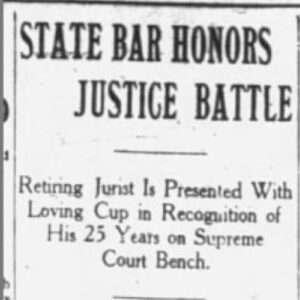calsfoundation@cals.org
Burrill Bunn Battle (1838–1917)
Burrill Bunn Battle was a prominent Arkansas attorney and jurist in the latter decades of the nineteenth century and the early part of the twentieth century. Although he was born in Mississippi, his family moved to Arkansas when he was a child, and it was there that he embarked on a legal career that culminated in a twenty-five-year tenure on the Arkansas Supreme Court.
Burrill B. Battle was born on October 24, 1838, in Hinds County in Mississippi. His parents, Joseph Battle and Nancy Stricklin Battle, were native North Carolinians, but when Battle was six, the family relocated to Arkansas, settling in Lafayette County, where he received his early education. From there, Battle attended Arkansas College in Fayetteville (Washington County), from which he earned a BA in 1856. He earned a law degree from Cumberland University in Lebanon, Tennessee, in 1858. Following graduation, he was immediately licensed to practice in Tennessee, but the following year, after being licensed by Len B. Green of Arkansas’s sixth judicial circuit, he set up a law practice in Lewisville (Lafayette County). He had to put his career on hold with the advent of the Civil War. Battle joined an artillery regiment of the Confederate army and fought in the Chickamauga and Murfreesboro campaigns, as well as in the Battle of Shiloh, among others. He served until the end of the war and was reported to have sustained injuries that permanently hampered his hearing.
At the end of the war, the young attorney returned to Lewisville, where he resumed his practice. However, seeking new opportunities, in 1869 he moved to Washington (Hempstead County), where he started a new law practice. In 1871, Battle was elected to the Arkansas House of Representatives. That same year, he married Josephine Cannon Witherspoon; the couple had no children.
In 1880, the couple moved to Little Rock (Pulaski County), where Battle opened another practice, establishing a partnership with Judge Freeman W. Compton. Their practice was thriving when, in 1884, Battle was first considered for a vacancy on the state Supreme Court. While he was passed over in that instance, Battle was elected to fill the vacancy caused by the 1885 death of Associate Justice John R. Eakin.
In over two decades as an attorney, Battle became a recognized leader of the state bar while establishing a reputation as a thoughtful and wise counselor. By his own admission, he did not like the turmoil of the trial courtroom, but his learned style made him an effective appellate attorney. Battle ultimately served on the bench for twenty-five years, a term of service which, at the time of his retirement, was the longest of any justice in Arkansas Supreme Court history.
Well regarded for his judgment, his vast knowledge of the law, and his work ethic, Battle earned the respect of the attorneys who appeared before the court. Indeed, the high regard in which he was held was reflected in the overwhelming reelection victories he achieved—first, in 1886, when he outpolled all other candidates, then in 1894 when he ran unopposed, and finally in 1902 when he was decisively elected despite having been the object of much pointed criticism from populist governor Jeff Davis. After his long and productive career, Battle opted to retire rather than run for another term in 1910.
In 1917, the state published its Digest of the Decisions of the Supreme Court of Arkansas and dedicated the work to Justice Battle. In retirement, he was actively involved in the local Missionary Baptist Church.
Battle died on December 21, 1917, in Little Rock. He is buried alongside his wife—who died in 1899—in Mount Holly Cemetery.
For additional information:
“Judge Burrill B. Battle.” Report of the Proceedings of the Bar Association of Arkansas 21 (1918): 118.
Looney, J. W. “Burrill Bunn Battle.” Arkansas Lawyer 47 (Spring 2012): 32–36. Online at https://issuu.com/arkansas_bar_association/docs/the_arkansas_lawyer_spring_2012issuu/34 (accessed February 16, 2023).
William H. Pruden III
Ravenscroft School
 Law
Law Post-Reconstruction through the Gilded Age, 1875 through 1900
Post-Reconstruction through the Gilded Age, 1875 through 1900 Burrill B. Battle Story
Burrill B. Battle Story 




Comments
No comments on this entry yet.